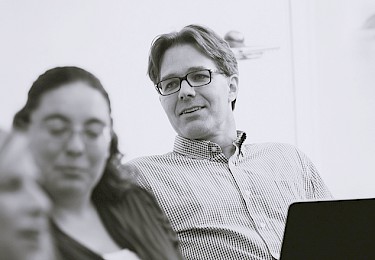Gene Therapy Consortium Meeting – A Parent’s Perspective

Dear Friends,
I had a remarkable experience recently at an all-day meeting in Boston with Monica and the scientists of RSRT’s Gene Therapy Consortium that I wanted to share.
The Consortium is a collaboration of four labs that are developing a way to use gene therapy to treat or maybe even reverse Rett symptoms. I certainly wasn’t expecting to add anything to the conversation at this meeting, and truth be told I was a little nervous about being there. I’m a parent, not a scientist, and here I was going to a meeting with some of the world’s leading gene therapy experts. This was going to be a far cry from tenth-grade biology class, which was a long time ago. I went to the meeting to be a fly on the wall, learn what I could, and try to get a big-picture sense of progress. It turned out I got all this, but I also got much more.
It was amazing and even moving to see these scientists talking so enthusiastically about gene therapy as a potential way to treat or cure our daughters. It’s one thing to read about these projects; it’s quite another to be there and see ten scientists (the four principal scientists brought lab members with them) discussing and sharing their progress. I was struck by how the Consortium is a true collaboration. These scientists were sharing ideas and resources freely, and I know they returned to their labs with critical new information. Something else that surprised me was their compassion. Maybe I was expecting a sort of detached scientific approach from them. But that’s not at all what I saw. TheConsortium members care deeply about their work and the impact it will have on those with Rett. They are constantly thinking about the details of gene therapy of course—the over-and under-expression of genes, DNA packaging, and vector optimization (a vector is the vehicle or “Trojan Horse” that carries a healthy gene to a mutated cell)—but it’s all driven by a desire to change lives. This was wonderful to see. We have Monica to thank for propelling these and other scientists to care about outcomes for our daughters as much as she and all of us parents do.
It was also clear at this meeting that meaningful progress was being made. I’ve learned enough about gene therapy to understand that the vectors that Consortium members are developing are critical. An effective vector will need to deliver just the right amount and parts of a gene, which is much easier said than done. At the meeting one of the Consortium scientists presented data on a vector tested in mouse models that looks promising. While this is very good progress, a lot more research lies ahead. Using gene therapy to treat Rett remains theoretical until the Gene Therapy Consortium members prove otherwise.
Science is complex and I know sometimes it’s hard to envision exactly how funding for it is used. At this meeting I had an acute sense of how every dollar contributed to RSRT matters—what I watched unfold that day simply would not have happened without the generosity of many people. It was another reminder of how grateful I am to everyone who supports RSRT. I feel lucky to have been there and to have had the chance to literally watch progress being made. The meeting renewed my excitement about the future for my daughter and all the other girls and women I’ve met with Rett Syndrome.
Tim Freeman


